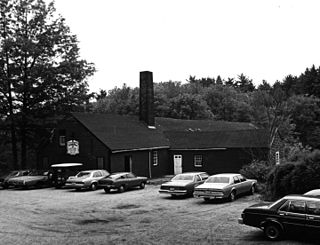
The Tack Factory was a historic industrial facility at 49 Tiffany Road in Norwell, Massachusetts, United States. With its oldest portion dating to 1834, it was the last surviving 19th-century mill building in Norwell prior to its destruction by fire in 1983. It was listed on the National Register of Historic Places in 1980. For most of its history it was used in the manufacture of horse tack equipment.

The Old Mill Site Historic District in Hatfield, Massachusetts encompasses the site of a late 19th century mill. It is one of only two such sites in the town. The centerpiece of the district is the former Shattuck Gun Factory building, which in 1989 housed newspaper offices and in 2006 a bed and breakfast. The district, which was listed on the National Register of Historic Places in 1982, includes three other elements: an 1891 Warren pony truss bridge across the Mill River, now closed to traffic, and a machine shop and garage, both built in 1886. The district was also included in the larger Mill-Prospect Street Historic District in 2002.
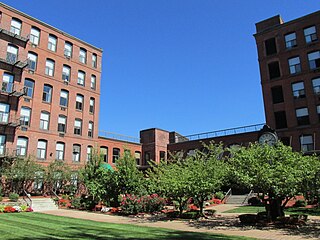
The Milton-Bradley Company is a historic former factory complex at Park, Cross, and Willow Streets in Springfield, Massachusetts. The factory was built beginning in about 1880, and expanded over the next decades to include a variety of brick multi-story buildings that are relatively utilitarian in appearance. When built, the property belonged to George Tapley, a principal in the Taylor and Tapley Manufacturing Company and a childhood friend of Milton Bradley. Bradley had entered the toy business in the 1860s, and moved his company to Tapley's premises in 1882.
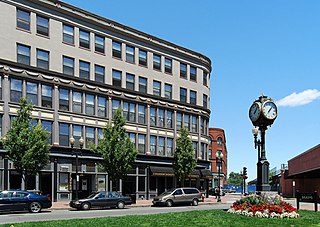
The Central Square Historic District is a historic district encompassing the Central Square area of downtown Lynn, Massachusetts. The area is at the confluence of a number of city streets, and includes buildings that border on Central Avenue, Willow Street, Munroe Street, Lake Street, Almont Street. It is a small part of Lynn's "Burned District", a large area of the downtown that was destroyed by fire in 1889. One of the first buildings built after the fire, the Bergengren Block, stands at the corner of Union Street and Central Square. It also includes the Mowers' Block, listed on the National Register in 1982.
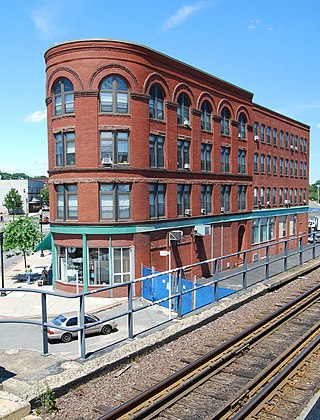
The Fabens Building is a historic commercial building at 312-344 Union Street in Lynn, Massachusetts. The four story brick building was built in 1890, replacing two buildings that were destroyed in Lynn's disastrous 1889 fire. It was built for William Fabens, a Marblehead lawyer and judge who maintained offices in the city and sat on the city police court. The building had seven storefronts on the ground floor, with office space on the upper floors. Designed by local architect Henry Warren Rogers, it is one Lynn's most significant Romanesque Revival buildings.

The G.A.R. Hall and Museum is a historic museum at 58 Andrew Street in Lynn, Massachusetts.

The Munroe Street Historic District encompasses some of the few commercial buildings to survive in downtown Lynn, Massachusetts from the mid 19th century. The district includes properties on Munroe Street between Market and Washington Streets, which was spared by the 1889 fire that destroyed much of Lynn's downtown area. It was listed on the National Register of Historic Places in 1996.

The Mowers' Block is a historic commercial block at Seven Willow St. and 67-83 Blake Street in downtown Lynn, Massachusetts. It was built in 1891 for the Mower & Brother shoemaking firm. The brick and granite building was built on the site of the Mower's old factory, in which the Great Lynn Fire of 1889 started, destroying not just their factory but a large swath of downtown Lynn as well. When completed, it was the largest building in the burned area.

The Lynn Realty Company Building No. 2 is a historic commercial building at 672-680 Washington Street in Lynn, Massachusetts. A long rectangular eight story brick building, it was built in 1902 to a design by local architect Henry Warren Rogers. The building is three window bays wide and seventeen long. Although it originally formally fronted on Washington Street, it extends on its long axis for most of a city block along Farrar Street. The original Washington Street entrance has been filled in, and the present entrance is now at what was the rear of the building, the southeast side, where there is a metal awning leading to a modern glass door. Windows on the street-facing sides are paired, with granite sills and header arches of a lighter-colored brick than the main body of the building. Brick pilasters rise between these paired windows the full height of the building, to a modestly-corbelled cornice.

The Lynn Bank Block is a historic bank building at 21–29 Exchange Street in Lynn, Massachusetts. The three-story building was built for the First National Bank of Lynn and the Lynn Institution for Savings in 1891. It was the first Colonial Revival construction in Lynn's rebuilding effort after a disastrous fire destroyed much of its central business district in 1889. Most of the earlier buildings erected after the fire were in Romanesque Revival styling. The building features a large central entry section with an arch framing a recessed doorway and a Palladian window above, which is flanked by columns. On either side of the entry the building extends for three window bays. The two banking institutions shared the building, one occupying each side.
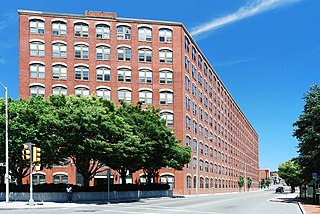
The Vamp Building is a historic factory building at 3-15 Liberty Square in downtown Lynn, Massachusetts. The eight-story brick building was built in 1903 as the Lynn Realty Company Building #4 to a design by local architect Henry Warren Rogers, and was extended over the next four years to occupy the entire city block bounded by Washington Street, Union Street, and Liberty Square. The "flatiron" V-shape of the building was the basis for its name, as it resembles the shape of the vamp of a shoe. The building served in its early years as a home for all manner of businesses related to the manufacture of shoes. At the time of its construction it was the largest brick building of its kind in the world.

The Stoneham Firestation is a historic fire station at Central and Emerson Streets in Stoneham, Massachusetts. The two-story red brick Renaissance Revival building was built in 1916, and continues to serve as the town's central fire station. Its most prominent feature is its four-story hose drying tower, which is reminiscent of Italian Renaissance-era towers. The building was listed on the National Register of Historic Places in 1984, and included as a contributing property to the Central Square Historic District in 1990.

This is a list of the National Register of Historic Places listings in Lynn, Massachusetts.

The H. W. Clark Biscuit Company is a former industrial complex in North Adams, Massachusetts. The bakery that Herbert W. Clark built at this site began at a facility on Liberty Street, and expanded into a shoe factory building that Clark had operated with a partner. When the Liberty Street plant was destroyed by fire in 1913, Clark placed its employees on a second shift in the shoe factory building, and had the building now called the Icing Building constructed. This building was built in a style reminiscent of mills built in North Adams fifty years earlier, and is still sometimes thought to be an older building.

The Kimball Brothers Shoe Factory is a historic factory building at 335 Cypress Street in Manchester, New Hampshire. The four-story brick building was built in stages between 1885 and 1900, and was a prototypical structure from which the design of other period shoe factories in Manchester were built. Construction was overseen by Head & Dowst, a builder responsible for a number of area public buildings, including schools and prisons. It was funded by local businessmen seeking to diversify the local economy, and was leased to the Kimball Brothers, a leading shoe manufacturer in Lynn, Massachusetts. The building was listed on the National Register of Historic Places in 1985.

The Cocheco Mills comprise a historic mill complex in the heart of Dover, New Hampshire. The mills occupy a bend in the Cochecho River that has been site of cotton textile manufacturing since at least 1823, when the Dover Manufacturing Company supplanted earlier sawmills and gristmills. The present mill buildings were built between the 1880s and the early 20th century, and were listed on the National Register of Historic Places in 2014.

Holman K. Wheeler was a prolific Massachusetts architect. Wheeler is responsible for designing more than 400 structures in the city of Lynn alone, including the iconic High Rock Tower which is featured prominently on the Lynn city seal. While practicing in Lynn and Boston over a career spanning at least 35 years Wheeler designed structures throughout the Essex County area, including Haverhill, Marblehead, Newburyport, Salem, Swampscott, and Lynn. Wheeler is responsible for a total of five Lynn structures listed on the National Register of Historic Places, more than any other person or firm.

The English High School is a historic former school building at 498 Essex Street in downtown Lynn, Massachusetts. Built in 1892 and enlarged in 1916, it served as the city's second high school until 1932, when the present Lynn English High School building on Goodridge Street was built. This building was listed on the National Register of Historic Places for its architecture in 1986. A total of five Holman K. Wheeler structures in Lynn are listed on the National Register. After serving for many years as a junior high school, it was converted into residential units.
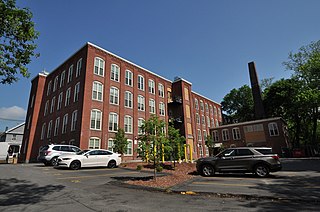
The W. S. Reed Toy Company-Wachusett Shirt Company Historic District encompasses two adjacent properties at 41 and 45 Summer Street in Leominster, Massachusetts. The two properties were historically associated with the business operations of William S. Reed, a businessman who operated a toy manufacturing company among other concerns. The properties were listed as a historic district on the National Register of Historic Places in 2021.
The Lynn Item Building is a historic commercial building at 38-54 Exchange Street in downtown Lynn, Massachusetts. It was built in 1900-1901 to a design by local architect Henry Warren Rogers. It was home to The Daily Item, the city's leading newspaper, until 2014, and is the city's only surviving 19th-century purpose-built newspaper building. It was listed on the National Register of Historic Places in 2023. It was converted to mixed commercial and residential use in 2021.






















